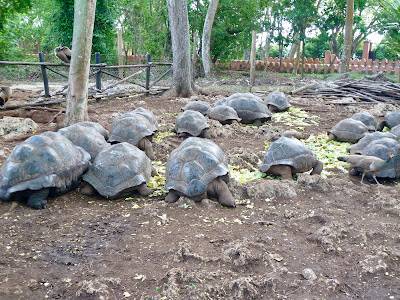We were encouraged to feed the beasts with greenery. They have a voracious appetite and jaws like car crushers. You feel they could take your fingers off if you are not careful. Fortunately they can't run too quickly. Riding on the tortoises is prohibited (as if I wanted to!). The only tortoises I have ridden, in races, were 'equine' ones.
Right: There is a pen housing lots of baby ones, I think called 'hatchlings', or maybe 'fingerlings'. I'm not sure (expert advice from my 'adviser' will be forthcoming). They obviously look after them well; they are a tourist money-spinner after all.
Left: The original gates to the quarantine centre; the grey ones.
Right: The inside courtyard with cells/rooms surrounding it. I think it has been smartened up a bit since its original use.
Left: There is even a fully stocked bar with a portrait of Sultan Sayeed Said on the wall by the drinks. Our guide was keen to have his photo taken against this. Were Sultans enthusiastic tipplers?
We sailed back via a coral reef where the lady in our little group, an enthusiastic diver, donned flippers and snorkel and went for a look-see down under (the sea!). She seemed to enjoy it. I am not particularly keen on submerging myself unnecessarily.
Right: The 'Travellers' Café' on the beachfront of Stone Town. It is a popular haunt for European tourists and ex-pats and is in fact a very pleasant bar/restaurant with charming staff and good WiFi. They have a decent (especially seafood) menu and a large glass of very palatable red wine costs about £1.80p. It has become my regular watering hole.
Left: The sunset view from the bar. The net is lowered when people play football on the beach, which they often do. Nothing worse than a football landing in your soup.
As well as football and swimming, lots of exercise is done on this little beach, especially, as I gathered, by the local police force. Right: This is a group of them pounding around a temporary running track.
I failed to get a video of an impressive dance group practicing their 'routines' with lots of gymnastics.
Left: A passing dhow. The colour of the sea around here always amazes me.
The next trip was to a Spice Farm, of which there are many, about 15km north-west near the town of Bububu. Zanzibar is historically renowned for spices, especially cloves and vanilla. It was indeed known as Spice Island during the 19th century. The notorious Tippu Tip (see previous blog) had a handle on the trade in this, as well as his ivory, and everything else.
I was travelling alone and was met by a guide and his young 'assistant' guide, neither of whose names I remember but, of course, they were very knowledgeable and charming. These spice farms operate as a local cooperative and cover, collectively, a large area.
I took several photos of the fruit trees and spice bushes I was shown, but pics of these are rather boring so I will just list an impressive selection of the things they were growing: Nutmeg, Cloves, Cinammon, Vanilla, Black pepper, Ginger, Tumeric, Curry leaves, Bread fruit, Jack fruit, Star fruit, Lychees, Cardamon (black, white and green), Cocoa, Coffee, Pepper, Limes, Avocado, Lemons, Pineapples, Lemon grass, Lipstick (Annatto), Quinine, Aloe Vera, Durian, Melons (various), Banana, Papaya and, of course, Coconuts. I might have missed a few. Some of these, I forget which, are used in the manufacture of perfumes. Not Durian, I hasten to add. There is a local dangerously (illegal) potent drink, Gongo, made from distilled papaya, much on the lines of the Irish Poteen and causes a few fatal hangovers. Similar to a cocktail I am familiar with, the 'Spiney Norman', but that is another story.
Right: The assistant guide displaying stars stuck on his face from cutting the tops off star fruit.
During the course of our walk he had been weaving, rather skilfully, a tie made out of palm leaf strips (or were they banana leaves) and a hat, plus flowers for my tie and buttonhole. I was encouraged to wear them so, in danger of embarrassing myself, here is a photo.
Right: I was treated to another fine display of palm tree climbing. A cloth strap tied between his ankles to grip the trunk and up he went like a scalded cat. Unlike a fat idle cat called Gordon of which I know which wouldn't try even with a shermooley stuck up its arse.
Left: I was persuaded to drink all of the coconut milk from one and then all the flesh. Not bad, and very healthy, but more than I would have normally wanted. Burp!
I'm really not sure that the hat suits me, but he (the guide) was quite fond of mine.
After this I was given lunch from a barbeque. Meat with spicey rice. Haven't a clue what it was. It tasted OK but plentiful, too plentiful.
There were stalls selling various spices and little bottles of perfume made from some of them. I bought one of them and will present it to an unsuspecting victim on my return. Probably Durian.
More to come from this place. I am beginning to find my way around and have much appreciated the genuinely welcoming nature of the locals and their fascinating diversity of cultures. Hope that doesn't sound too 'woke'.
I will leave you guessing!





















I will let the reference to being a Brit slide due to excessive red wine consumption but the young lady comment is going too far, you can see she is the same age as the tortoise
ReplyDelete